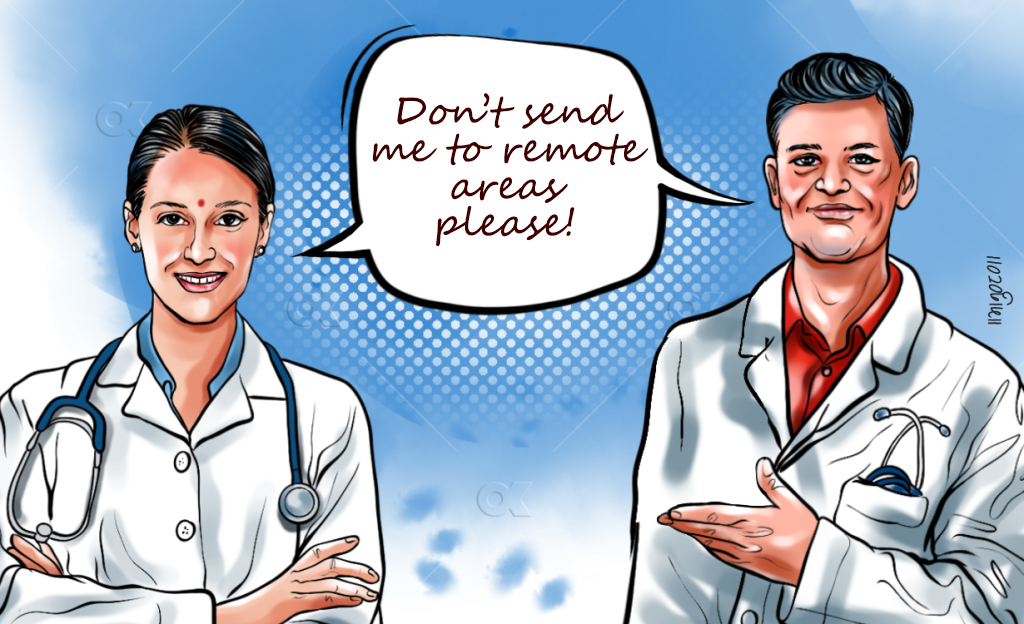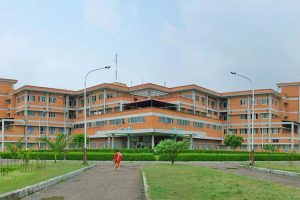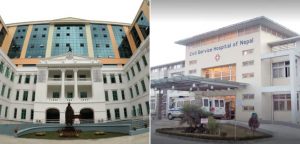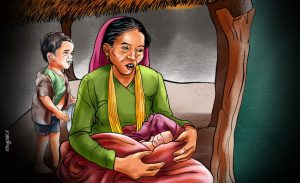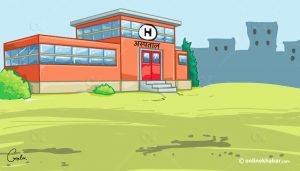
It was 3 pm on September 19. The emergency ward at Kanti Children’s Hospital was overcrowded and filled with distressed children in pain. Outside, one after another ambulance came and went. Two nurses were busy deciding which patient should be prioritised first, based on the triage system.
Helping them, the security staff lets patients in based on their ticket numbers. Inside, two doctors are examining the sick children individually.
The scene inside was even more glum. The emergency ward is full. With no beds free, three children are sharing one bed. Nurses are busy attending to one patient after another. Parents are frustrated as their child has been ignored.
Someone yells, “The patient here is extremely ill.” Unfortunately, there are no healthcare workers to immediately address the growing concerns. They only get a non-verbal reply, “After attending to another patient, I will come to you,” from a distressed nurse reaching the red zone.
“It has been half an hour since the child is struggling, and no one seems to care. What kind of carelessness is this?” shouted a woman loudly.
While parents are expressing their concerns, the hospital administration can only respond that the skilled professionals necessary to provide quality services are insufficient.
This depicts the current state of emergency services in one of the most vital child hospitals in the country.
Change of pace

On September 4, five-year-old Regisha Gopali resident of Bafal in Kathmandu, was taken to Kanti’s emergency ward at 5 am on Monday due to a high fever and vomiting. When the family expressed the worsening health condition of the girl, the emergency service staff instructed them to join the queue.
Unfortunately, Gopali did not receive timely treatment and passed away at 7 pm. Her relatives mentioned that they waited in line for nearly two hours for medical attention, but her turn did not come.
Following this incident, the hospital administration has made arrangements to admit patients according to the triage system (red, yellow, and green) based on priority.
Unconscious and severely ill patients are designated to the red zone, while individuals who are conscious but experiencing breathing difficulties are allocated to the yellow zone. Patients with minor health issues, who can be discharged after a few hours of monitoring, are housed in the green zone.
As per the emergency ward data, approximately 100 children seek treatment every day, with the highest influx occurring after 5 pm. The closure of OPD services at 1 pm has a direct impact on the emergency service offered by the hospital.
Emergency wards in hospitals have set standards to deliver fast and high-quality services to patients in critical condition. However, the emergency wards, originally set up to offer such services, are now in a state of disarray.
On September 21, at Patan Academy of Health Sciences in Lalitpur, patients had to be placed on the floor due to lack of space. According to Dr Samita Acharya, over the past three weeks, the influx of patients has surged, leading to a lack of space to accommodate the patients.
The hospital’s emergency service receives up to 170 patients seeking treatment daily. With only 35 beds available, the emergency is always chaotic with patients waiting for long durations. At least two patients are referred daily due to the scarcity of ICU beds. With a shortage of skilled medical officers, doctors and infrastructure, the hospital’s emergency service is also crippled.

The waiting game
Kanti Children’s Hospital, the sole government hospital in the capital dedicated to treating children, stands as a beacon of hope and trust for the underprivileged and the impoverished. Children with intricate health issues who arrive at the hospital often require admission to a ward or placement in the ICU after an assessment in the emergency ward.
However, securing an ICU bed is a challenging task. Beds become available either when children being treated are discharged after recovery or sadly, in the event of death. Another alternative is to transfer patients to a different hospital. According to data from Kanti Children’s Hospital, due to the lack of ICU beds, approximately five to seven referrals are made daily.
When ICU beds are unavailable in government hospitals, parents are compelled to seek assistance from private healthcare facilities. The cost of an ICU bed in a private hospital alone exceeds Rs 15,000 per day, which is exorbitant for the middle class and the financially disadvantaged.
Hence, numerous parents endure a wait of two to four days in the emergency ward, clinging to the hope of securing an ICU bed for their child. Unfortunately, during such trying periods, some individuals are left with no alternative but to witness the agonising passing of their children.
A similar situation could be seen in the green area of the Tribhuvan University Teaching Hospital (TUTH), on the afternoon of September 13.
A male patient and a female patient sharing Bed No. 3, awaiting treatment. Most of the beds in the green area had a similar view while some patients were even in wheelchairs. The space is highly congested, so much so, that the security personnel were escorting the patient’s relatives out due to the crowd.

Meena Tamang, a 40-year-old from Sindhupalchok, had visited the emergency ward complaining of weakness and leg pain. Within a short while, another patient was allocated to the bed, in the green area, she was allocated after a long wait. The occupants of the overcrowded bed were coughing persistently. Some were coughing out blood.
Witnessing this, Tamang grew concerned about potentially contracting another illness from the hospital. Unfortunately, her relatives felt helpless and could not voice their concerns to anyone in the hospital.
Shubhadra Adhikari from Panchkhal of Kavre shares a similar concern regarding the emergency ward’s crowded conditions, stating, “Two or three patients are sharing a single bed, including those with communicable diseases. Who will bear the responsibility if someone seeking treatment ends up falling ill tomorrow?”
On September 15, at 10 am, an ambulance stopped at Bir Hospital’s entrance. The patient belonged to the red zone, but the emergency wardwas dreadfully overcrowded. The patient’s relatives desperately searched for a stretcher, but they could not find one nor could they find an empty bed.
Resorting to a wheelchair, the relatives transferred the patient to the emergency ward, where the patient got hooked up to oxygen.
About two hours later, the 70-year-old patient Iswari Prasad Neupane from Gorkha was assigned a bed in the emergency ward. He was an asthma patient in urgent need of ICU care. However, the doctor informed them that Bir Hospital did not have an ICU and advised them to seek arrangements elsewhere.
His son was evidently frustrated searching for a bed, but he did not have any luck. And their financial situation did not allow them to opt for private hospitals.

Their option was to wait, and they finally got a bed in the ICU. But his condition deteriorated significantly, and he tragically lost his father. After Neupane’s passing, another individual’s turn for the ICU arrived, and this cycle continued.
Lack of professionals and infrastructure
According to Teaching Hospital, in July/August, 3,715 patients sought treatment in the emergency wards. Among them, 483 individuals (13 per cent) received treatment in the red area (for critical patients), 1,225 individuals (33 per cent) in the yellow area (for patients with serious conditions), and 1,708 individuals (54 per cent) in the green area (for patients with less severe conditions).
In the emergency medicine department, there is one associate professor and three assistant professors, two resident doctors specialising in emergency medicine (DM) and one in emergency medicine (MD). Furthermore, there is one doctor each with qualifications in anaesthesia (MD), critical care (DM), and MDGP (MD) who serve on a rotational basis.
There are 18 medical officers and some intern doctors, who work in three shifts. Each shift requires five doctors to manage the emergency ward. Meanwhile, approximately 150 patients arrive at the Teaching Hospital, which has a 60-bed emergency ward. Due to the lack of infrastructure, a majority of patients in the emergency ward, in the red and yellow areas, await their turn for admission even up to two to three days.

Dr Ramesh Maharjan, the head of the Teaching Hospital’s emergency ward, emphasises their commitment to treating every patient, regardless of the volume. However, due to a shortage of skilled medical officers and available beds, patients are compelled to wait their turn.
“Ideally, around 50 per cent of the patients arriving at the emergency ward should be admitted and treated. However, the reality is that only about 20 per cent of patients can be admitted daily. At times, admitted patients have to be treated for up to seven days, meaning a lack of beds. And due to overcrowding, about 6 per cent of patients request referrals and opt to go to other hospitals,” says Maharjan.
In Kanti, there are 17 staff nurses, with four to five nurses on each shift. However, a significant challenge is the shortage of skilled medical officers. Despite plans to establish a 52-bed ICU during the tenure of the former Health Minister, Gagan Thapa, it has remained non-operational due to a shortage of skilled medical officers and inadequate physical infrastructure.
Bibhuti Kattel, the nurse in charge of the emergency ward, expresses concern about the inadequate staffing levels as the patient numbers increase. She mentions that as they are so stretched sometimes the parents of patients become agitated due to the lack of timely responses.

Dr Shree Ram Tiwari, the head of Kanti Hospital’s emergency ward, highlights that, by international standards, there is still a 40 per cent deficiency in human resources.
Bir Hospital, the country’s oldest and largest hospital, is equipped with 45 beds in the emergency ward. However, each day, around 150 patients seek medical assistance. To manage this, the hospital deploys 10 MDGP doctors, and 28 medical officers, on a daily basis, with eight doctors and six nurses working per shift. Despite the operation of 75 ICUs in Bir, hospital statistics reveal that due to bed shortages, two to four people have to be referred daily
Emergency wards need correction
The building of Patan Hospital’s emergency ward is in a dilapidated state, impeding the provision of effective services due to weak physical infrastructure. Dr Samita Acharya explained that due to this substandard physical infrastructure, providing service as expected becomes challenging. During rainfall, occupants sometimes have to use a bucket to address leaks. Despite having a capable workforce, the inadequate physical infrastructure hinders effective service delivery.
“We need to address the condition of the emergency ward first,” Acharya says.
The depiction of the conditions in the emergency wards of the four major hospitals in the valley provides a clear indication of the state of affairs in remote hospitals.

The constitution also upholds basic healthcare as a fundamental right, as stated in Article 35: “Every citizen shall have the right to receive basic health services free of charge from the state, and no one shall be deprived of emergency health services.”
However, the suffering of citizens lying helplessly in government hospital beds highlights the contrary reality.
Public Health Dr Sharad Onta stresses that citizens face challenges in accessing healthcare due to administrative problems within the health sector system. “Emergency services are a matter of life and death, yet they have not been efficiently managed.”
Public health experts say under the pretext of healthcare expenses, government officials and leaders accumulate substantial sums of money from the state fund. Ironically, the general public is often left in a predicament where they must sacrifice their own treatment. This has led to the commercialisation of the health sector, a consequence of the state’s negligence and lack of accountability.
Onta argues that if the state acknowledges its responsibility towards patients, even with limited structures, patients should not be denied essential services.
“It is imperative to establish a comprehensive system that ensures accessibility to all healthcare services outlined in the constitution,” he says.
This story was translated from the original Nepali version and edited for clarity and length.






